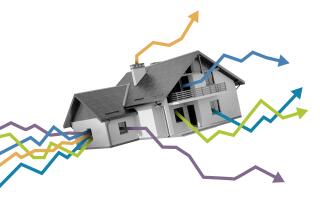Affluent Areas Lead Recovery in Real Estate
- Share via
Los Angeles County’s real estate market continues to climb out of the depths of the recession of the early 1990s, but the region’s more affluent neighborhoods have made markedly greater gains than other areas, according to property tax data to be released today.
Overall, the county’s real estate assessments increased by $30 billion, or 6%, last year, a boost that shuts the door on years of decline in property values that led to government crises and financial hardship for homeowners.
“We’re in a revitalization here,” Assessor Kenneth P. Hahn said in an interview. “Homeowners can feel that the value is back for their most expensive purchase.”
The rise in property tax assessments is not only a sign of the Los Angeles area’s expanding economy, but has swept about $70 million into county coffers, enabling the Board of Supervisors to authorize the construction of new libraries and sheriff’s and fire stations.
That’s quite a contrast to just four years ago. Property tax receipts actually were shrinking and supervisors mulled closing hospitals as the county tottered on the brink of bankruptcy.
“Over the last few years we’ve been fanning the embers, keeping the property tax system alive,” Hahn said, “and now we’ve finally got a fire in the furnace.”
The statistics reflect the value Hahn’s office placed on all real estate in the county--commercial and residential--as of Jan. 1. That value is used to compute property taxes.
Despite the boost, real estate values in Los Angeles remain lower than they were before the property market crash earlier this decade. And the county statistics show that some areas have yet to fully realize gains in the newly crackling market.
Growth in assessed value is nearly stagnant in the Antelope Valley and such blue-collar cities as La Puente, Artesia and Paramount. Long Beach saw the assessed values of its properties inch up by only 1.7%.
Baldwin Park even posted a loss of 7%, the only decrease in value registered. That drop was attributed to a tax-exempt property being placed on the rolls for the first time, dragging down the city’s totals.
More affluent cities, meanwhile, posted eye-catching gains. Beverly Hills properties were assessed at 12% higher value than the previous year; Manhattan Beach assessments rose 11.7%; West Hollywood went up 9.9%. Westlake Village posted the sharpest increase at 13.1%.
The disparities did not surprise Hahn. The Westside, he said, “has always been, and I assume it will always be, a more desirable place to live.”
Hahn added that he believes areas that did not post such impressive gains will still continue to climb.
Assistant Assessor Rick Auerbach noted that high-end real estate depreciated further and faster than other properties during the recession. “They’ve gone down first,” he said, “and they’ve gone up faster.”
Property values have been soaring in exclusive areas, with the baby boom generation treating itself to high-end purchases fueled by low interest rates, the stock market boom and expansion in the entertainment industry. The overall increase of home sales in the county has raised concern that some families are being priced out of single-family homes, squeezing the rental market.
But even with those gains, and a 6.8% rise in the city of Los Angeles’ assessed real estate value, single-family homes have yet to return to the values they held as recently as 1992, according to the assessor’s report.
Los Angeles County’s assessment increases still lag behind those of other large counties, such as San Diego or Santa Clara, Hahn said, a sign that Los Angeles’ real estate market is a latecomer to California’s real estate recovery.
And of the 366,000 parcels examined by assessors to see if previous year declines should be altered, only 29,300 were restored to their highest level, while 48,000 declined further.
“We haven’t seen the end of it,” Hahn said, referring to the recession’s impact on real estate. “But [the market] is coming back and it’s coming back strong.”
One positive sign, Hahn said, is that the current recovery lacks the speculation that drove real estate prices to untenable heights in the late 1980s. “Now people are more knowledgeable about what they’re buying,” he said.
Another hopeful indicator is that the number of foreclosures dropped to 27,000, the lowest in six years.
Hahn said he believes assessed values will rise again next year, and although he said he couldn’t predict beyond that, he remains optimistic about the future.
“We will have sustained growth,” he said.
(BEGIN TEXT OF INFOBOX / INFOGRAPHIC)
Mixed Assessments
A snapshot of the percentage change in real estate assessments in Los Angeles County as of Jan. 1 compared with last year:
City: Beverly Hills
% change: 12.03
City: Cerritos
% change: 4.61
City: Compton
% change: 4.25
City: Downey
% change: 2.32
City: El Monte
% change: 1.53
City: Glendale
% change: 6.49
City: Lakewood
% change: 3.55
City: Long Beach
% change: 1.66
City: Los Angeles
% change: 6.83
City: Monterey Park
% change: 2.55
City: Pasadena
% change: 5.18
City: Pomona
% change: 2.42
City: Ranchos Palos Verdes
% change: 9.75
City: Santa Clarita
% change: 7.61
City: Santa Monica
% change: 11.02
City: Torrance
% change: 5.57
City: West Covina
% change: 5.20
* Source: Los Angeles County assessor’s office.
More to Read
Inside the business of entertainment
The Wide Shot brings you news, analysis and insights on everything from streaming wars to production — and what it all means for the future.
You may occasionally receive promotional content from the Los Angeles Times.









